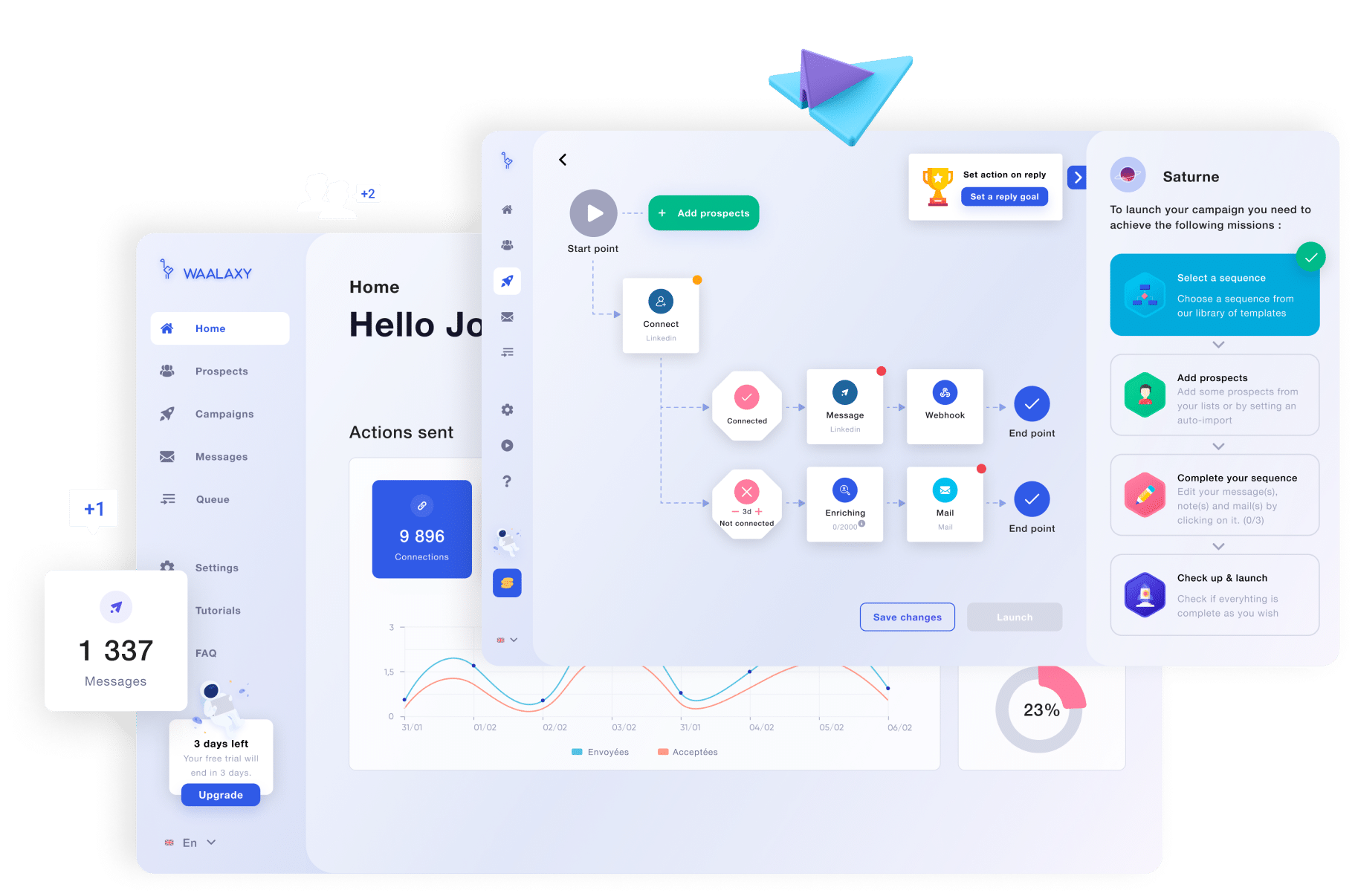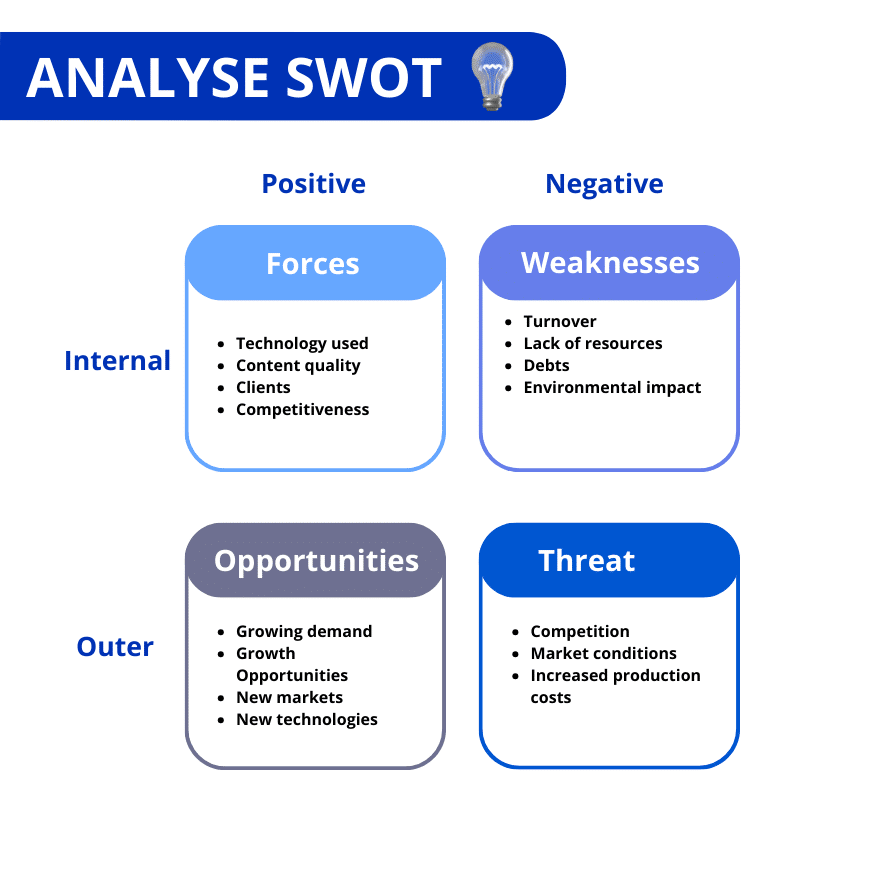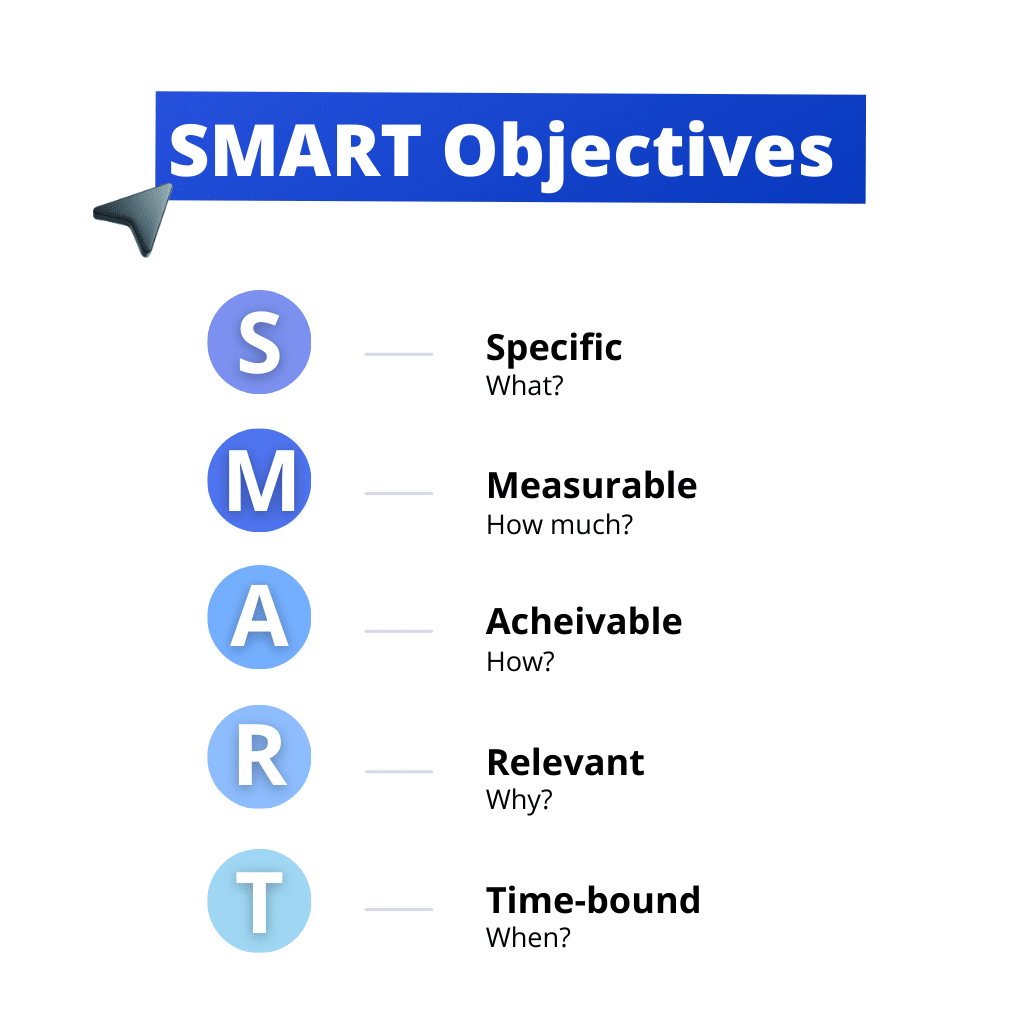These days, social media have become a central pillar of communication and marketing, which is why a social media strategy is a must.
For businesses of all sizes, having a strategy is essential if you want to establish a strong online presence, engage your target audience and achieve your goals. 🎯
Without further ado, we explain everything! 👀
What is a social media strategy?
A social media strategy is an action plan designed to manage and optimize a brand or company’s presence on social media platforms. 👀
It involves creating, publishing and promoting content in line with your target audience, as well as interacting and engaging with this audience. 💬
- 🟣 Quickly, here’s a short list of goals you can aim for:
- 🔵 Increased brand awareness.
- 🟣 Lead generation.
- 🔵 Improved customer engagement.
- 🟣 Customer support.
- 🔵 Sales conversion.
- 🟣 Social listening.
This list is just an example, so feel free to adapt it to your company’s specific needs. 🫶🏼
Why set up a social media strategy?
If you’re wondering, you haven’t yet understood the benefits of a social media strategy. 🤔
It’s all about visibility, customer engagement and experience, and business development. Let me explain: ⬇️
- 1️⃣ Increased brand visibility: offer a huge showcase for brands, reaching millions of users worldwide.
- 2️⃣ Enhanced engagement: facilitate direct, personal interaction with customers and prospects.
- 3️⃣ Generate traffic to the website: publish content that includes links to the company’s website.
- 4️⃣ Understanding and listening to the market: a rich source of information on consumer behavior, preferences and needs.
- 5️⃣ Online reputation management: monitor and actively respond to both positive and negative customer feedback.
- 6️⃣ Cost-effective: low-cost platform to reach a wide audience.
- 7️⃣ Competitive intelligence: monitor competitors’ activities, and adjust strategy.
For each of the above points, here is an example to illustrate what we mean:
| Reason | Example |
|---|---|
| Increased brand visibility | A personalized hashtag campaign to promote a new product on Instagram, reaching a global audience. |
| Strengthening commitment | Facebook contests encouraging users to share their experience with the product to win prizes. |
| Generate traffic to your website | Publication of blogs on LinkedIn with links to the company’s website for more in-depth discussion of the topics covered. |
| Understanding and listening to the market | Using Twitter to gather customer feedback on a service, using sentiment analysis tools. |
| Online reputation management | Monitor brand mentions on social networks and respond quickly to customer concerns to maintain a positive image. |
| Cost-effectiveness | Launch of targeted Facebook advertising campaigns on a limited budget, measuring engagement and increased web traffic. |
| Competitive intelligence | Analyze competitors’ social network publications and campaigns to identify trends and adjust your own strategy. |
Get your first customers this week
Take advantage of the power of Waalaxy to generate leads every day. Start prospecting for free, today.

How to create a social media strategy in 10 steps?
Now that you know why it’s important to have a social media strategy, you’re probably wondering, okay but, how do you do it? 🤔
Well, that’s where I come in, with an easy-to-understand 10-step guide! Take notes, it’s going to kick ass! 💪🏼
1) Analyze the current situation
To launch a social media strategy worthy of the name, it’s crucial to start with some good old-fashioned soul-searching, but for your brand! 👀
Indeed, analyzing the current situation is a bit like doing a check-up before taking your road-trip in the car, you check the condition of the engine and the oil levels. 🚙
Except here, the oil level is your product or service and your engine is your current market and your competitors. 😇
Okay, but how do I do it? 🤔
Start by taking a look at your product or service and asking yourself if your product is living up to your expectations, if your customers are still as satisfied. 💟
Next, take a look at what your competitors are doing on social networks and analyze their social media strategy. 🧐
That’s where the SWOT method comes in! Analyze your strengths, weaknesses, opportunities and threats in table form.

This will give you an overview of your brand, product or service. ✈️
2) Setting goals
Now it’s time to set goals for your social media strategy. 🤩
In the charming realm of social media, objectives fall into 3 categories:
- 👑 Brand awareness: getting more people to know your brand, a bit like making your company the star of the party.
- 👑 Engagement: encouraging your audience to interact with your content.
- 👑 Conversion: turn interest into action, whether sales, registrations or downloads.
But that’s not all! To make sure these goals don’t remain mere dreams, you can apply the SMART method.
It lives up to its name, and I’ll tell you why: 👇🏼
- Specific (be precise).
“Increase brand awareness” is a good start, but “increase brand awareness by 25% among 18-25 year olds on Instagram”, is a real goal.
- Measurable (the objective must be quantifiable).
“Having more followers” is vague, but, “Getting 1,000 new followers”, is a measurable and quantifiable figure.
- Achievable (be realistic).
Aiming for a million new followers in a month with no budget is like hoping to win the lottery without buying a ticket.
- Realistic (feasible with available resources).
If your marketing budget is closer to that of a lemonade stand, don’t plan a campaign worthy of the latest Marvel movie.
- Time-defined (set a deadline).
“Increase sales through social networks”, is a goal with no timeline, but “Increase sales by 20% via social media in 6 months” has an end, like your favorite fairy tale.

3) Define your target audience
Defining your target audience is when you choose the travel companions who will make the adventure not only possible, but memorable. 🥰
Indeed, knowing your audience is essential to ensure that the message reaches those who will love your product or service the most. 💟
To do this, ask yourself the following questions and follow these steps:
- 1️⃣ Who are they?
Are they young professionals addicted to their smartphones, parents looking for practical advice, or students with a penchant for sustainable development? Every detail counts.
- 2️⃣ What do they want?
Identify 🔎 their needs, desires, and pain points. Understanding their motivations will enable you to create content that really resonates with them.
- 3️⃣ Where do they hang out?
Which social platforms do they spend most of their time on? A presence on TikTok may be a must if you’re targeting Gen Z, while LinkedIn will be more appropriate for a professional audience.
- 4️⃣ How do they like to consume content?
Do they prefer short, punchy videos, detailed articles or informative infographics?
By asking yourself all these questions, you’ll be able to fine-tune your strategy so that it fits with the right people, at the right time and in the right way. 😇
4) Define your communication channels
This step is essential in building your presence on social networks, just like choosing the right plot of land to build your home. 🏡
Nothing should be left to chance, as each social network has its own characteristics, audience and type of content.
Let us chew 🥗 the work for you with a list of the different social networks:
- 💙 Facebook: A multi-faceted platform, ideal for reaching a vast audience through posts, videos, and groups.
- 💜 Instagram: Perfect for visual communication with photos, stories, and short videos to captivate a younger audience.
- 🕊️ Twitter: Ideal for quick updates, real-time discussions, and direct engagement with followers.
- 🩵 LinkedIn: The professional network par excellence for sharing value-added content, forging business relationships, and posting job offers.
- 🤍 Pinterest: A channel for inspiring through images and ideas, particularly effective for web traffic and e-commerce.
- ❤️ YouTube: The platform of choice for sharing long-form videos, tutorials, and vlogs
Next, choose your social network(s) based on the type of content you can produce on a regular basis. For example, if you’re more comfortable creating captivating visuals, Instagram and Pinterest might be your best allies.
Conversely, for more informative content, Facebook or LinkedIn are more appropriate. 👀
However, the key 🔑 is not to spread yourself too thin. It’s better to master a few relevant channels than to be moderately present everywhere.
5) Create accounts
The fifth step is to create accounts. It’s a bit like planting your brand’s flag in a vast digital territory, claiming your space on the chosen platforms! ⛳️
There are a few prerequisites for this (nothing serious, I promise 😇).
First of all, you need to choose the right username. It needs to be recognizable, easy to search and consistent across all platforms, as this helps build a strong brand image and thus makes it easier for your audience to find you. 🔍
Then, use a professional e-mail address, because, not only will it look more professional, it’ll help you manage your accounts in a secure and organized way. 📖
Don’t forget to fill in your profile with a clear, concise description of what you do, and include relevant keywords for your SEO! (Psshiit, don’t forget the professional profile photo that matches your brand’s visual identity).
Finally, if possible, get your accounts officially verified. It adds a level of credibility and trust. 🫱🏽🫲🏼
6) Optimize your profiles
Optimizing your social networking profiles is a bit like putting on your best suit for a job interview: it’s the first impression you make on your audience, and you want it to be memorable for all the right reasons!
Whether on Instagram, Facebook or LinkedIn, every detail counts.
However, the strategies are not the same for the 3 social networks:
- 💜 Instagram: make sure your bio is concise but informative, use relevant keywords, choose a high-quality profile photo and use front-page stories to highlight your best offers.
- 💙 Facebook: your business page should clearly communicate who you are and what you do. The cover and profile photo should be aligned with your brand identity. Little tip, don’t forget to add opening hours if you have and contact information.
- 🩵 LinkedIn: your profile should emphasize your expertise and credibility. So use professional language for your description and make sure your employment history is up to date.
In any case, whatever social network you choose, don’t forget to add a link to your website! 💡
7) Create and publish content (who, what, how, where, when)
This is where the magic happens. 🪄 You’ll be able to post lots of photos, texts and videos that will have a real impact with your current and future community! 🤩
But first, ask yourself the following questions:
- 1️⃣ Who? Identify the content creators in your team, if any. Is this a task for the community manager or a content specialist? Either way, make sure the tone and voice of the brand are consistent.
- 2️⃣ What? Determine the type of content that will resonate with your audience. This could be educational infographics, video tutorials, case studies or even entertaining publications (avoid dancing cats).
- 3️⃣ How? Well-crafted, original and engaging content is more likely to capture attention and encourage interaction. Don’t forget to include clear CTAs to guide your audience.
- 4️⃣ When? Use analytics to determine the best times to publish, maximizing your visibility and engagement. Use a publishing calendar to stay organized and maintain a regular presence on social networks.
8) Define a publication schedule
Defining an editorial calendar is a bit like navigating the ocean with a map and compass, it’s much more practical! 🤩

Without a calendar, you’re bound to get lost and forget what you published two months ago.
Here’s what you need to do:
- Frequency ➡️ identify the ideal publishing rhythm that keeps your brand fresh in the minds of your audience.
- Diversify your content ➡️ it should reflect a balanced mix of content types, from informative articles to engaging videos.
- Events ➡️ Incorporate important dates for your brand and your sector into your planning, such as product launches, public holidays or annual events in the marketing calendar such as Christmas, Valentine’s Day or Black Friday.
9) Evaluate performance
It’s a bit like doing a health check on your brand. It’s a time to understand what’s working, what’s not, and where you can improve your approach.
To do this, you can follow this little plan: 👇🏼
| Step | Description |
|---|---|
| Use of analysis tools | Use platform-specific tools (e.g. Facebook Insights, Instagram Analytics) to obtain data on engagement, reach, etc. |
| Measuring KPIs | Define and track key performance indicators aligned with your objectives, such as engagement rate, number of followers, or web traffic generated. |
| ROI analysis | Evaluate the effectiveness of social network marketing efforts in terms of costs and benefits to understand return on investment. |
| Data-based adjustments | Use the insights gathered to make strategic adjustments, whether in terms of content type, publication timing or other aspects. |
10) Adjust your strategy
The final but essential step is to adjust your strategy. Because yes, once you’ve implemented your strategy, analyzed the data and measured performance, it’s time to fine-tune and optimize. 💪🏼
To do this, you can do the following: 👇🏼
- Social listening: capture feedback, trends and conversations around your brand.
- A/B testing: experiment with different types of content, publication times and messages to see what works best.
- Adapt to trends: stay on top of new platforms, features and content trends.
- Ongoing training: invest in ongoing training for your team to keep abreast of the latest strategies.
4 common mistakes to avoid
Avoiding some common mistakes can make the difference between a strategy that pays off 🍇 and one that falls flat.
Here, for your eyes only, are the 4 most common mistakes!
1) Start creating content without a strategy
Launching a content campaign without a clear strategy is like sailing without a compass: you don’t know if you’ll reach your destination 🤷🏼♀️.
We can’t stress this enough, but before producing content, it’s crucial to define your objectives, know your audience and understand how your messages fit into the customer journey. 💬
2) Don’t define targets
Without a clear understanding of who you want to reach, your messages may lack focus and relevance. 🥲
To do this, don’t forget to define personas for your audience, which can help you create engaging content. As an added bonus, it allows you to optimize your advertising campaigns (like an sms marketing campaign) to reach those who are most likely to be interested in your products or services. 👀
3) Wrong goals
If you set goals that aren’t aligned with your brand, it can have a negative impact on your results. 😭
In fact, your social media objectives need to be specific, measurable, achievable, relevant and time-defined (remember the SMART method at the start of this article?).
Whether it’s to increase brand awareness, generate leads or improve customer service, each objective needs to be clearly defined. 👽
4) Reaching too many people
By trying to reach 🎯 everyone, you may be reducing the effectiveness of your communication.
In this case, take a more targeted approach, targeting specific segments of your audience.
Our little tip? 🤔
Use demographic and behavioral data to refine your marketing targeting and thus personalize your content. 😇
How about a recap?
In conclusion, we’d like to remind you that you need to avoid common mistakes such as the absence of a content strategy, the lack of target definition, the setting of inappropriate objectives, as well as excessive targeting. By doing so, you lay the foundations for a solid and engaging online presence. 💪🏼
Remember that a successful social media strategy is measured not just by the number of likes or followers, but by the quality of interactions and relevance to your target audience. 💡
Frequently asked questions
Don’t rush off, we still have a few resources to share with you. 😇
How do you deploy a social media strategy?
Implementing a social media strategy starts with understanding your audience and your objectives. To do this, follow these steps: 👇🏼
- 1️⃣ Define your objectives (brand awareness, engagement, web traffic or conversions).
- 2️⃣ Identify your target audience (their preferences, the platforms they frequent most).
- 3️⃣ Create relevant, engaging and authentic content.
- 4️⃣ Use data and analytical tools to track publication performance.
- 5️⃣ Stay up to date on social media trends.
What are the 3 most popular social networks?
The most widely used social networks vary by region and demographic group. However, Facebook, YouTube and Instagram top the list. 🏅
These platforms offer a variety of tools for brands to engage their audience, from content marketing to targeted advertising campaigns. 🎯
What are the 4 types of media?
Here are the 4 types of media:
- Paid media ➡️ purchased advertising space, such as PPC ads, sponsorships and product placements.
- Owned media ➡️ communication channels that you directly control, such as website, blogs and social media accounts.
- Earned media ➡️ organic recognition, such as press mentions, positive reviews and word-of-mouth.
- Shared media ➡️ content distribution via social media, where sharing by users amplifies your reach.
Now you know all about social media strategy! 🐉




